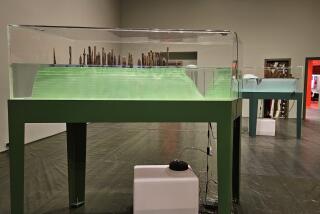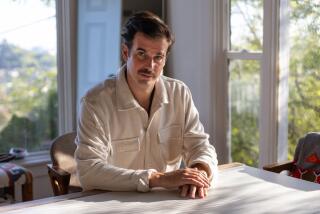Moscow Museum Gets Real : Art: ‘The Way to Political Pluralism’ at the Museum of the Revolution, once a shrine to the Bolsheviks, revels in talking about once-forbidden subjects.
- Share via
MOSCOW — Banners proclaiming “Down With the Communist Party” and “Market Economy--Yes” now line museum walls long reserved for propaganda about the victory of Marxist-Leninist ideals in the 1917 Bolshevik Revolution.
A new exhibit, “The Way to Political Pluralism,” is on view in the Museum of the Revolution, which until recently had been the showcase for the Soviet leader of the day to force his ideas on the children who filed through by the thousands on school trips.
Topics now on display include the political life of scientist and human rights campaigner Andrei D. Sakharov, the refugees from ethnic strife across the country, the fast-growing environmental movement and the drives for independence in the Baltic republics.
“There is a very stormy political life in our country right now,” said Svetlana V. Lifanova, 45, the historian in charge of exhibit. “Many people do not have clear ideas of the political forces battling for power.
“We hoped to show them the stormy political life and give people an opportunity to compare different political platforms and ideas.”
Although many of the materials on display here could have brought their owners seven years in prison for anti-Soviet propaganda not long ago, Lifanova said the Museum of the Revolution is the obvious place for such an exhibition today.
“Soviet President (Mikhail S.) Gorbachev calls this a revolution--although it is a peaceful revolution,” she said. “There really is a revolution going on, especially in the consciousness of the people.”
But for museum-goers, such political heresy in a setting that was once a shrine to the Bolsheviks, their revolution and their party is hugely ironic.
“It’s very funny for a Soviet person to see this,” said Masha M. Voltenstein, a physicist, “because we are used to things in museums having absolutely no connection with reality.”
Items on display ranged from the flag of Pamyat, a Russian nationalist group with anti-Semitic leanings, to ration coupons for sugar and a telegram to the liberal Inter-Regional Group of Deputies to the national parliament.
“The people are behind you. Down with the 6th Article. Create a party,” the telegram read. Delivered at the Kremlin, the telegram was sent by a Muscovite to encourage the liberal legislators to delete from the constitution the article guaranteeing the Communist Party’s leading role in the life of the country.
Once-banned flags, anti-Communist newspapers, platforms of new political parties and photographs of the most controversial recent events filled the exhibit, which is scheduled to remain in place for at least four more months.
The exhibit is so up-to-date that it even has materials from July’s 28th party congress, including a political cartoon lampooning the battle between conservatives and liberals.
In the cartoon, discredited Soviet leaders Josef Stalin and Leonid I. Brezhnev are standing in front of the Kremlin’s Palace of Congresses. Stalin whispers to Brezhnev, “Our guys still aren’t surrendering,” in an obvious illusion to the hard-liners’ stubborn refusal to give up power.
The preparation of the exhibit itself shows how much change there has been since 1987, when the museum was still a custodian of the official line on the past and curators were prevented from getting their hands on archival material such as documents about Stalin’s victims.
“At last, we don’t have to hide anything,” said Lifanova, who has worked at the museum for 21 years. “Before, history was seen through the prism of party ideology. This is the historic truth we have always dreamed about.”
For the exhibit on political pluralism, a group of museum historians gathered authentic materials of the current political scene. Banners used in recent demonstrations are on display. Ration coupons were collected from around the country. Some of the photographs of the recent ethnic clashes were taken by local residents.
One banner is at the expense of former leader Nikita S. Khrushchev, who often boasted that the Soviet Union would excel in every imaginable category, both important and mundane. The banner reads, “We will catch up and overtake America in the quantity of milk and will catch up with and overtake America in the quantity of political parties.”
The Soviet Union has already achieved that goal: More than 20 new political parties and organizations were represented at the exhibit alone.
Visitors were visibly affected as they viewed the roll-call vote that spelled the end of the Communist Party’s monopoly, notes legislators had scrawled to themselves and casual photographs of popular heroes.
“This is really unusual,” Igor A. Sviridov, 54, an unemployed metalworker, said while viewing material on the Ukrainian independence movement. “It’s the first time I’ve seen many of these things.
“If Lenin were here, he would call Lubyanka and have this closed down and all those involved thrown in jail,” Sviridov said, using the slang name for the offices of the KGB, the Soviet security police.
More to Read
Sign up for Essential California
The most important California stories and recommendations in your inbox every morning.
You may occasionally receive promotional content from the Los Angeles Times.










